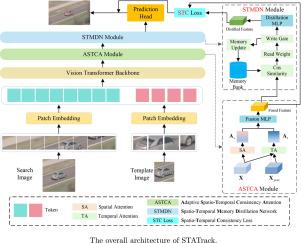基于一致性感知记忆蒸馏的时空自适应视觉跟踪
IF 7.6
1区 计算机科学
Q1 COMPUTER SCIENCE, ARTIFICIAL INTELLIGENCE
引用次数: 0
摘要
由于现实世界场景中外观、遮挡和不同运动模式的复杂变化,视觉对象跟踪提出了重大挑战。本研究提出了一种基于Transformer架构的新型跟踪框架STATrack,旨在通过以下三个关键贡献来解决这些挑战:(1)自适应时空一致性注意(ASTCA)模块,该模块采用并行注意机制有效地对齐和集成多尺度特征,增强了模型对外观变化的适应性;(2)时空记忆蒸馏网络(STMDN),该网络有效地管理动态记忆,以跨帧保留和精炼目标特定信息;(3)时空一致性(STC)损失,增强了时间相干性,显著降低了跟踪抖动,提高了轨迹稳定性。在7个具有挑战性的基准测试中进行的综合实验表明,STATrack实现了最先进的性能,在GOT-10k上的AO值为76.4%,在LaSOT上的AUC为72.7%,在TrackingNet上的AUC为84.7%,同时保持了38 FPS的实时处理效率。这些结果突出了STATrack在提高跟踪鲁棒性和准确性方面的有效性,使其成为视觉跟踪实际应用的一个有前途的解决方案。本文章由计算机程序翻译,如有差异,请以英文原文为准。

STATrack: Spatio-temporal adaptive transformer with consistency-aware memory distillation for visual tracking
Visual object tracking poses significant challenges due to complex variations in appearance, occlusions, and diverse motion patterns in real-world scenarios. This research presents STATrack, a novel tracking framework based on the Transformer architecture, aimed at addressing these challenges through three key contributions: (1) the Adaptive Spatio-Temporal Consistency Attention (ASTCA) module, which employs parallel attention mechanisms to effectively align and integrate multi-scale features, enhancing the model’s adaptability to appearance changes; (2) the Spatio-Temporal Memory Distillation Network (STMDN), which efficiently manages dynamic memory to retain and refine target-specific information across frames; and (3) the Spatio-Temporal Consistency (STC) loss, which enforces temporal coherence, significantly reducing tracking jitter and improving trajectory stability. Comprehensive experiments across seven challenging benchmarks demonstrate that STATrack achieves state-of-the-art performance, with 76.4% AO on GOT-10k, 72.7% AUC on LaSOT, and 84.7% AUC on TrackingNet, while maintaining real-time processing efficiency at 38 FPS. These results highlight the effectiveness of STATrack in enhancing tracking robustness and accuracy, establishing it as a promising solution for practical applications in visual tracking.
求助全文
通过发布文献求助,成功后即可免费获取论文全文。
去求助
来源期刊

Knowledge-Based Systems
工程技术-计算机:人工智能
CiteScore
14.80
自引率
12.50%
发文量
1245
审稿时长
7.8 months
期刊介绍:
Knowledge-Based Systems, an international and interdisciplinary journal in artificial intelligence, publishes original, innovative, and creative research results in the field. It focuses on knowledge-based and other artificial intelligence techniques-based systems. The journal aims to support human prediction and decision-making through data science and computation techniques, provide a balanced coverage of theory and practical study, and encourage the development and implementation of knowledge-based intelligence models, methods, systems, and software tools. Applications in business, government, education, engineering, and healthcare are emphasized.
 求助内容:
求助内容: 应助结果提醒方式:
应助结果提醒方式:


